The moral embedded in Aesop’s “The Hare & the Tortoise” fable didn’t always seem to apply to restaurant businesses in the pre-pandemic world as operators rushed to make a profit and show growth, particularly as more private equity companies invested in restaurants. In that go-go-go world, Foosackly’s remained staunchly committed to the tortoise approach.
The Mobile, Ala.-based chicken finger chain grew from 1 to 13 stores in 20 years. Not exactly a lightning-speed growth rate. Menu changes? Virtually nonexistent — the one menu item the owners anticipate adding seems stuck in a research-and-development loop.
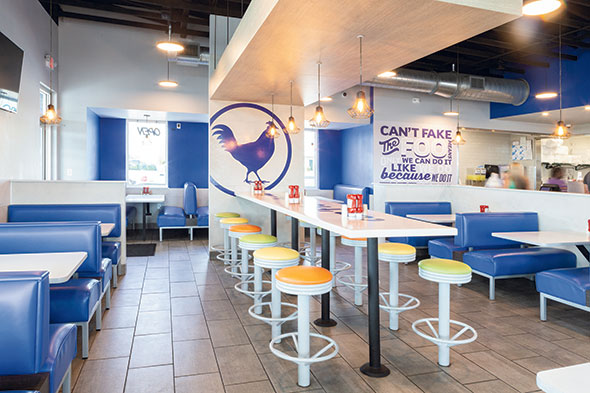 Foosackly’s newest store in Tillman’s Corner, Ala. Photos by Brad Puckett, BP Photography
Foosackly’s newest store in Tillman’s Corner, Ala. Photos by Brad Puckett, BP Photography
Of course, the tortoise does actually win the race. And, while the tortoise didn’t have the ability to move quickly, Foosackly’s differs in that it chooses a slow and steady pace.
Meticulous Focus
Foosackly’s business centers on one item: chicken fingers. It’s the only protein on the menu (save bacon for its bacon queso fries).
The simplicity of Foosackly’s menu matches the simplicity of its corporate hierarchy. Neither of the two executives leading the chain carry a title much less a business card, although the outside business world would likely assign Will Fusaiotti the title of CEO and his partner, Eric Brechtel, the title of chief operating officer. Internally, people simply refer to the duo as Will and Eric.
The unassuming approach to titles and modest menu does not correlate to an easygoing or unsophisticated operation. In fact, the singular focus on chicken fingers enables acute attention to both menu and operational details. Weekly sales targets are nearly 98% accurate according to Fusaiotti, and on-site operations follow suit.
“A screen in the back of the house shows the person staffing the chicken station exactly how many chicken fingers they should have down,” Fusaiotti says. It’s that kind of exact operating science Fusaiotti doesn’t want to put at risk with a new menu item, specifically a grilled item. “It’s tough to add to the menu without slowing down the core,” he explains. “People have an expectation of how long it will take for their food when they come in.”
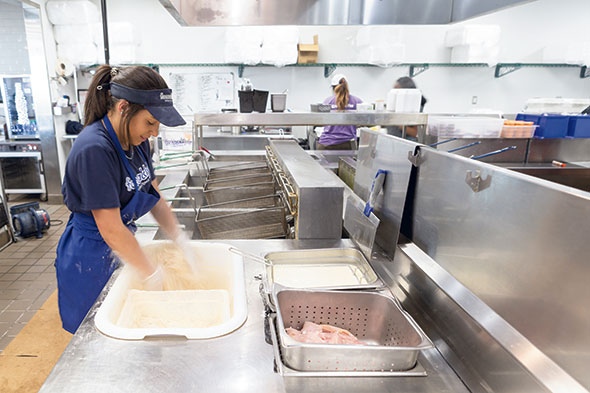 Foosackly’s staff bread all chicken tenders by hand, at a pace of a case or two an hour.
Foosackly’s staff bread all chicken tenders by hand, at a pace of a case or two an hour.
In the quest for the perfect grilled chicken, Fusaiotti and Brechtel have spent a lot of time testing different equipment, including various sous vide applications and clamshell griddles. Combi ovens are also in the test cycle, as a potential cooking method for bacon and possibly its Texas toast, both of which staff currently cook on a griddle.
“They’ve tested every piece of equipment that could cook any of their products,” says Dale Greenstein, senior sales representative for Mobile Fixture & Kitchen Equipment Co. Inc. The Mobile, Ala.-based equipment dealer has worked closely with the chain since its early days. “They won’t settle for anything that won’t cook to exactly what they need.”
To date, nothing meets their standard for a grilled chicken item. “We are very picky,” Fusaiotti says. “The challenge is to meet timing and quality parameters. We do not have a specific target date to launch a grilled product. That’s not how we operate.”
The owners agree, however, that a grilled item represents a necessary addition as both the brand and its customer base continues to evolve. “Our customers who started with us have also gotten older with us over the past 20 years,” Fusaiotti notes. His goal it to maintain that long-term customer base, who may now have dietary restrictions. For now, the grilled item remains in a holding pattern. Maybe, Fusaiotti says, since so much has been put on hold due to the COVID-19 pandemic, it will allow more time for research and development. “Since equipment suppliers and vendors may not be going 100 miles an hour right now, it may allow a chance to recalibrate and allow time and energy for something new,” he says.
Back-of-the-House Tweaks
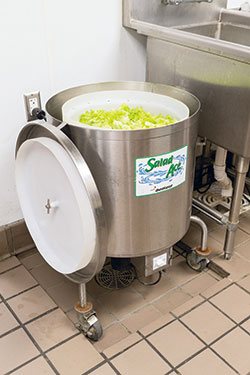 A recessed area with a drain keeps the salad dryer in one spot when in use. It’s the kind of operations-oriented adjustment Foosackly’s executives consistently seek to improve. The newest ground-up store, in Tillman’s Corner, Ala., opened at the beginning of 2019 and serves as the company’s prototype at 3,000 square feet. While other chains may view a prototype store as an opportunity to adopt an entirely new approach to many things, for Foosackly’s it represents a go-forward model that incorporates many tweaks over the years. “We are a menu-based operation, so the buildings were not the priority in the early days,” explains Fusaiotti.
A recessed area with a drain keeps the salad dryer in one spot when in use. It’s the kind of operations-oriented adjustment Foosackly’s executives consistently seek to improve. The newest ground-up store, in Tillman’s Corner, Ala., opened at the beginning of 2019 and serves as the company’s prototype at 3,000 square feet. While other chains may view a prototype store as an opportunity to adopt an entirely new approach to many things, for Foosackly’s it represents a go-forward model that incorporates many tweaks over the years. “We are a menu-based operation, so the buildings were not the priority in the early days,” explains Fusaiotti.
Over time it became clear the buildings were getting beat up, says Fusaiotti, and the chain started to make adjustments. “We put laminate on the walls, which really helped — the edges are way more durable,” he says. Another change was to switch to a heavy-duty tile flooring. And the changes kept on going from there.
The back-of-the-house/front-of-the-house split now sits at 50.5% for the former and 49.5% for the latter. One notable back-of-the-house transition over time took the chain from a traditional, linear cookline to a T-shaped setup. Culinary staff bread and deep fry chicken tenders on one side, and grill Texas toast and cook fries on the other side. The efficient lineup of cooking equipment includes two banks of fryers (one for chicken tenders and one for fries, which sit parallel and face each other), plus a griddle.
A 9-foot-by-14-foot walk-in cooler stores the majority of product; french fries are the only item that ships frozen to stores, held in a 9-foot-by-6-foot freezer. The large size of the walk-in cooler helps leverage chicken tender orders with suppliers, says Fusaiotti, by enabling Foosackly’s to increase the drop size of deliveries. Stores receive chicken deliveries up to four times a week.
“It’s the exact opposite setup of most QSRs,” says Greenstein, “where, typically, the freezer is huge and the cooler is small.”
A single door reach-in cooler and freezer also sit on the main cookline. Additional equipment components include a warmer for queso, a breading mixer, a juicer to hand-squeeze lemonade (stores routinely go through nearly four cases of lemons a day) and a salad dryer.
Staff bread all chicken tenders by hand, at a pace of a case or two an hour, on a custom make table. A drop-in ice well holds the protein on top of the make table, which sits next to a fryer-basket-style drop-in well for the batter. A plastic tub sits closest to the staffer breading the chicken tenders.
On the opposite side of the chicken tenders, a Foosackly’s staffer cooks Texas toast, which Foosackly’s considers almost something an art form to obtain the proper internal temp and desired crisp on the outside. Staff use a griddle and hand press to accomplish the task, almost caramelizing the bread on both sides. One of the major benefits of having few menu items, in Fusaiotti’s view, is the ability to perfect them.
The remainder of the back-of-the-house lineup follows suit in the art of perfection. “It’s a very exact setup,” says Greenstein of the back of the house. The chain uses only electric equipment on its cookline, something he believes provides better temperature regulation in the warm Southern climate.
Tempered air also helps avoid a hot kitchen and provides a comfortable back-of-the-house environment for staff. “It’s an expensive proposition to do the hood that way — an island-style hood with tempered air,” Greenstein notes.
The change to the hibachi-style hood happened after the first five stores were built. It helps with employee comfort and provides a reason for people to stay, says Fusaiotti. “People appreciate working in a comfortable space.” Foosackly’s also plays music in the back of the house to add a fun vibe to the work environment. The owners consistently look for ways to improve things, which extends from the culture to equipment.
The Foosackly’s team tweaked the salad dryer by adding a recessed area with a drain to stop the machine from traveling across the back-of-the-house area when in use. “It was a bit like R2-D2 before, even with locks on the wheels,” jokes Brechtel. “The recessed tile area is a result of asking ourselves “What could be better?’” The new setup locks the machine into place, and it’s easier to maintain.
“We’re taking a lot more control of the individual pieces of equipment,” says Brechtel. The breading mixer provides another example: Foosackly’s buys the parts and fabricates it locally to its own specs.
Even the addition of the salad dryer itself is the result of the what-could-be-better approach: The chain switched from bagged lettuce to hand-cutting and washing it all in-house to better control inventory.
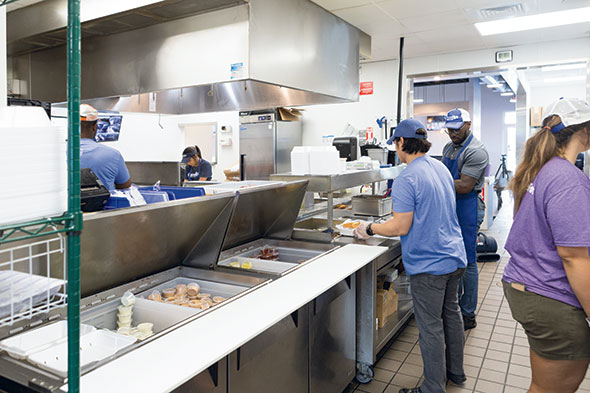 A custom work table houses a three-compartment setup for chicken fingers, fries and Texas toast. A nearby refrigerated unit holds six house-made sauces. Stores can go though as many as 40 gallons of sauce in a day.
A custom work table houses a three-compartment setup for chicken fingers, fries and Texas toast. A nearby refrigerated unit holds six house-made sauces. Stores can go though as many as 40 gallons of sauce in a day.
Front-of-the-House Elements
Staff plate items for in-house dining orders on a plastic melamine container and set them on the pass-through window. Another employee delivers orders tableside; staff also bus tables.
Variable seating styles offer customers a range of options that include traditional tables with chairs, booths and a community high-top table with stools. “The big key for us is having a lot of different seating options for families,” says Fusaiotti, who adds that the most popular spot in the house is the large corner booth that seats 10 people. “It’s a favorite,” he says.
That particular booth sits between the door and the ordering counter and offers almost a private seating nook. Wood beams and pendant lights add a homey touch to the booth.
Different lighting heights throughout the dine-in space help define seating options. A dropdown ceiling further defines the community table, which includes a custom inlay with the chain’s tagline “can’t fake the foo.”
Customers can choose between drive-thru and pickup options for off-premises consumption. The chain does not participate in any third-party delivery programs. “Fried food doesn’t travel as well as, say, barbecue and other items and we prefer to maintain control over the product quality,” Fusaiotti says.
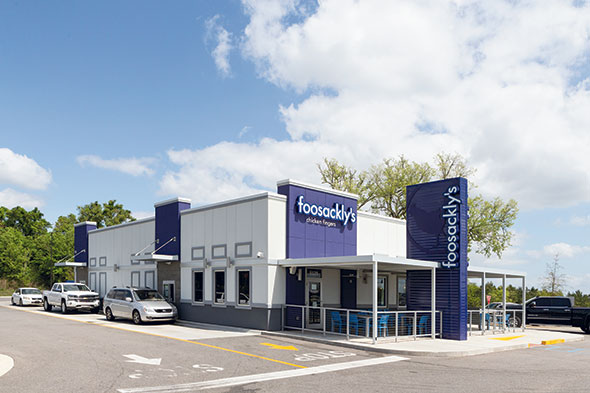 Foosackly’s newest store in Tillman’s Corner, Ala., can routinely have 190 transactions in an hour.The drive-thru functions via a face-to-face service model. “It’s far more personal and active,” says Fusaiotti. He views the approach as a differentiator but admits it can be confusing for people not familiar with the brand, who sometimes drive up and start talking to a menu board with no speaker component. Signage directs customers to order at the window, and, during busy periods, a staffer takes orders via a tablet outside to speed the ordering process. Customers still pay for orders at the window, even if they place orders on the tablet, although Fusaiotti says they are working out the security kinks to implement paying via the tablet.
Foosackly’s newest store in Tillman’s Corner, Ala., can routinely have 190 transactions in an hour.The drive-thru functions via a face-to-face service model. “It’s far more personal and active,” says Fusaiotti. He views the approach as a differentiator but admits it can be confusing for people not familiar with the brand, who sometimes drive up and start talking to a menu board with no speaker component. Signage directs customers to order at the window, and, during busy periods, a staffer takes orders via a tablet outside to speed the ordering process. Customers still pay for orders at the window, even if they place orders on the tablet, although Fusaiotti says they are working out the security kinks to implement paying via the tablet.
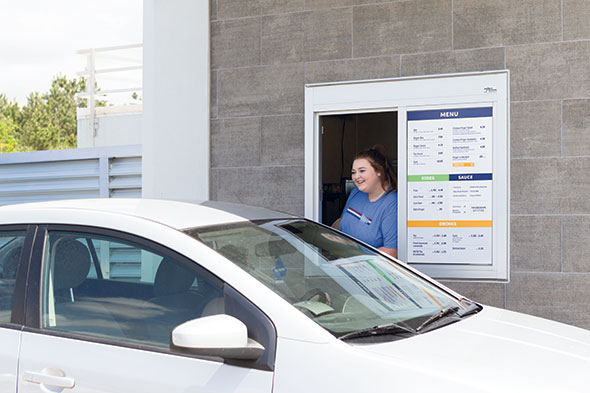 All drive-thru ordering happens face to face.
All drive-thru ordering happens face to face.
Pivot Due to COVID-19
Renovations on the chain’s in-progress store in Tuscaloosa, Ala., began in early March. The renovation project of an existing restaurant building (formerly a Schlotzsky’s) continues, although the COVID-19 pandemic might affect the planned summer opening.
“These are unchartered waters for everyone,” says Fusaiotti of the environment around COVID-19. “It’s a little bit of wanting to get out and do stuff but pressure to not do anything.”
Foosackly’s has been around the block more than once with disaster situations. The chain was just starting with its first store when 9/11 hit and has found a way to keep operating through the BP oil spill that impacted coastal Alabama in 2010 and several hurricanes. Fusaiotti can still recall hearing a local reporter talk about the one gas station and restaurant open in town after Hurricane Katrina. That one restaurant was Foosackly’s.
“We had just opened that location,” Fusaiotti recalls. “We had 30 cars in the drive-thru; customers couldn’t make their way out of the store. We were overwhelmed. We did twice as much business in four hours than we ever did in a day — people drove 40 miles for one hot meal.” His father helped by standing in the parking lot and explaining the menu to people waiting to order because so many had no idea what the chain offered.
That stay-open mentality remains amid COVID-19. While in-store dining shut down, drive-thru and pickup options remain available.
Sales are down, but all stores remain open for business. Some labor issues adjusted naturally, particularly stores near college towns where the primary workforce of college students returned home. Other employees have requested not to work, largely younger employees whose parents do not want to risk their children being exposed to the virus.
The college connection is a good fit with the brand, Fusaiotti says, but he prefers a little distance from campus to avoid too much reliance on students. The store near Auburn University sits about a mile and a half from campus, and the Tuscaloosa store will draw customers from nearby University of Alabama when complete.
Campus proximity also brought some learnings, such as the first home football game at Auburn University. Orders came in for 100-plus chicken fingers at a time, and at one point the screen in the back of the house was telling staff they needed 5,000 chicken fingers, Fusaiotti says. Foosackly’s added a catering truck, located behind the restaurant, for the next home game.
Growth Vision
As far as a grand vision for growth, the owners do not have a target date to reach a set number of Foosackly’s. “And that’s a vision in itself,” says Brechtel.
And while the chain has been approached about franchising, the owners agree that franchising would run counter to all the control components the chain continues to perfect. “We are not going to choose a franchising path,” confirms Fusaiotti.
The chain relies on its base of 55 full-time managers — that’s an average of four managers per store — to maintain the corporate culture as the company grows. “It’s a large number of managers,” admits Fusaiotti, “but without them, I don’t know that I’d want to grow.” Most managers have been with the chain for at least five years. Generally, two managers work each shift.
“We promote existing managers to newer markets or locations and fill out the management team internally,” says Fusaiotti. “More than 90% of our current leadership team of 55 began as hourly crew.”
The owners plan to continue to build the chain throughout the northern part of Alabama and also Florida. Foosackly’s currently operates two stores in Florida, both in Pensacola. “A lot of people from Mobile travel to that area,” explains Fusaiotti. “We will continue to build brand recognition in that region.”
The company is pricing locations to build on two parcels it owns in Florida; one has an existing building — a closed QSR — on the land, and the other piece of land is a raw outparcel. Based on learning from past retrofits and newbuilds, the owners continue to weigh the options of which strategy to apply. “It’s surprising that the rebranding price isn’t that much less than building a ground-up prototype,” says Fusaiotti. He adds that he doesn’t feel like he gets exactly what he wants when redesigning an existing space.
And getting exactly what they want is a running theme for the owners of Foosackly’s.
Backstories
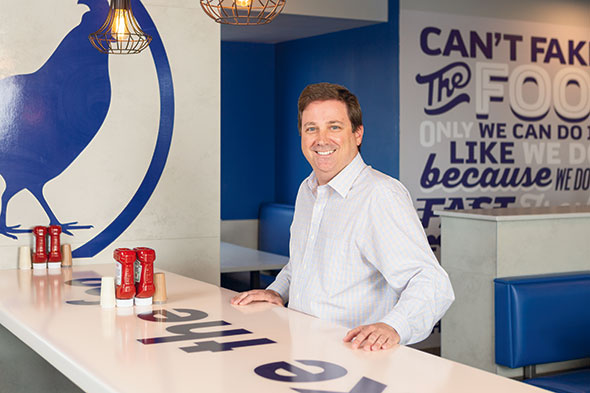 Will Fusaiotti, co-founder of Fooslacky’s, enjoys the “foo” connections that play off the chain’s branding that play off the chain’s name. The “can’t fake the foo” tagline appears on a text wall in the store and is also inlaid into a tabletop.Foosackly’s partners Will Fusaiotti and Eric Brechtel became friends during their first year in college at Louisiana State University. After college, Fusaiotti came up with the idea of starting a limited-menu concept; his parents were Smoothie King franchisees, so he was familiar with foodservice and spent time working in his parents’ operation.
Will Fusaiotti, co-founder of Fooslacky’s, enjoys the “foo” connections that play off the chain’s branding that play off the chain’s name. The “can’t fake the foo” tagline appears on a text wall in the store and is also inlaid into a tabletop.Foosackly’s partners Will Fusaiotti and Eric Brechtel became friends during their first year in college at Louisiana State University. After college, Fusaiotti came up with the idea of starting a limited-menu concept; his parents were Smoothie King franchisees, so he was familiar with foodservice and spent time working in his parents’ operation.
Brechtel was a sales rep with Sysco before joining Fusaiotti to open that first store in 2000. “It was a motiving factor to be our own boss,” he recalls. “We were young and naïve and made a ton of mistakes.” The two took things day by day, focusing on operations, customers and its own people — a plan that continues to drive the company.
Along the way, one of the chain’s regulars, a sales rep for an equipment and supplies dealer, finally convinced Fusaiotti to work with him. That rep was Walne
Donald Jr., now chairman of Mobile Fixture Equipment, and that initial sales relationship grew into a longstanding business relationship and friendship. And that tight dealer-operator partnership is something Fusaiotti credits to the prototype becoming as efficient as it is today
Facts of Note
- Chain headquarters: Mobile, Ala.
- Key players: Will Fusaiotti and Eric Brechtel, co-founders
- Year founded: 2000
- Signature menu item: chicken fingers
- Number of units: 13, with No. 14 under construction
- Unit size: 3,000 sq. ft.
- Front of the house: 1,215 sq. ft. for customer area, 300 sq. ft. for restrooms
- Back of the house: 1,485 sq. ft.
- Seats per unit: 82, plus 21 patio seats at some locations
- Location type: freestanding
- Unit growth projections: 2 locations in Florida
- Check average: $7.25
- Equipment package cost: $275,000
- Equipment dealer and kitchen design consultant: Mobile Fixture & Kitchen Equipment Co. Inc.: Dale Greenstein, senior sales representative
- Architect and engineer: Mouton Long Turner Architects, Metairie, La.: Bert Turner, principal




